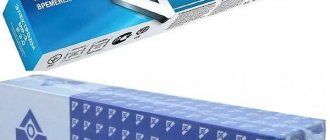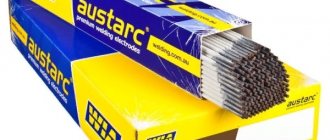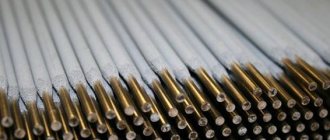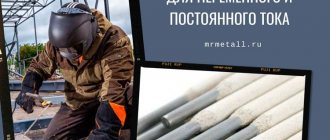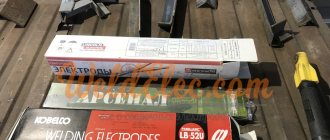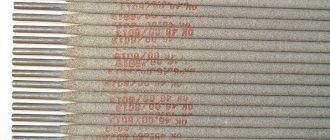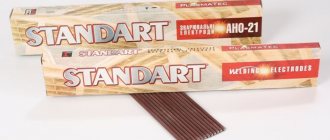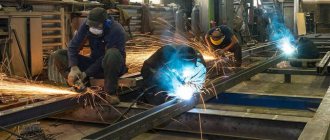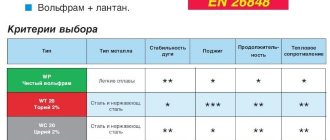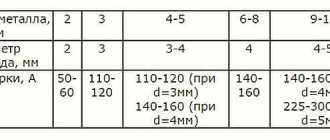Types of electrode coating: basic, rutile, acidic, cellulose.
A welding electrode is a metal rod capable of conducting electricity. There are several types of welding electrodes, melting and non-melting. The consumable electrodes are coated with a special coating - coating, which consists of various components.
The main task of electrode coating is to protect the weld pool from external influences, ensure uninterrupted burning of the arc and create a seam that meets special characteristics. Therefore, depending on the welding tasks, electrodes are produced with different coatings: rutile, having a basic, cellulose and acid coating.
Types of electrode coating: basic, rutile, acidic, cellulose
Answering the question of how rutile electrodes differ from electrodes with a basic coating, one can understand that the main difference is in the composition of the coating. The filler in this case is various substances, the percentage of which varies greatly for electrodes with different coatings.
According to the type of coating, electrodes are divided into the following:
- Acidic - letter designation (A);
- With rutile coating (P);
- Having a basic coating (B);
- With cellulose coating (C);
- Having a mixed type of coating (two letters in the designation);
- Electrodes with other types of coatings (P).
Mixed types of coatings include electrodes coated with:
- Acid-rutile coating;
- Rutile-cellulose coating;
- Rutile base coat.
The characteristics of the electrodes largely depend on the type of coating. Therefore, it is very important to understand where it is best to use electrodes with the above four coatings: basic, rutile, cellulose and mixed.
What does a welding electrode consist of?
By and large, an electrode is a piece of wire through which electric current passes during welding. The surface is covered with a special chemical composition that determines the properties of the product. There are electrodes that are just a piece of wire and do not have any additional coating. They are called uncovered.
Consumable and non-consumable electrodes
The rod inside the electrodes is made of metal and, less commonly, of copper rod. Its task is to fill the weld pool with a melt that connects two workpieces to each other. The coating around the metal rod determines the chemical characteristics of the electrode and contains substances that improve the quality of the seam.
Non-consumable electrodes are made from powdered materials. The most commonly used are coal or tungsten. They improve the quality of adhesion of the parts being connected. The weld is formed without melting the metal rod, and the electrode material is consumed as filler wire. The most common material used in the production of such electrodes is amorphous carbon. The finished product is an elongated oval rod.
This kind of carbon electrodes is used to form seams with high aesthetic values. They are also in demand for air-arc cutting of thick metal workpieces.
Electrodes for spot welding
Separate attention should be paid to equipment intended for spot welding. Features of the technology are to preserve the initial shape of the parts being connected and ensure the required degree of electrical conductivity.
To solve problems of this kind, special devices are provided that work without conventional electrodes. Their role is replaced by special copper contacts made in the form of pointed rods. At home, such contacts can be made independently. For example, use waste tips from powerful soldering irons.
Electrodes with basic coating
The basis of this coating is fluoride compounds. In terms of its chemical composition, the metal deposited with electrodes with a basic coating is very close to mild steel. The welding seam is characterized by high levels of impact strength, strength and ductility, due to the low content of electrodes, non-metallic inclusions, gases, and also harmful impurities in the coating composition.
Electrodes with a basic coating are somewhat inferior to other electrodes in terms of sensitivity when welding rusty metals. Also, during the welding process, pores often form on the seams. Electrodes with a base coating are quite sensitive to moisture, so they quickly become damp, requiring calcination before use.
Types of coated electrodes for manual arc welding of structural steels
According to GOST 9467, electrodes for welding structural steels are classified depending on the mechanical properties of the welded joint obtained by welding with one or another electrode and are divided into types presented in the table:
Electrode type
| Mechanical properties of weld metal | Purpose | |||
| Tensile strength, MPa | Relative extension, % | Impact strength, J/cm2 | ||
| E38 | 380 | 14 | 30 | Welding of carbon and low-alloy steels, structural steels with tensile strength up to 500 MPa |
| E42 | 420 | 18 | 80 | |
| E46 | 460 | 18 | 80 | |
| E50 | 500 | 16 | 70 | |
| E42A | 420 | 22 | 150 | Welding of carbon and low-alloy steels, steels with increased requirements for ductility and toughness |
| E46A | 460 | 22 | 140 | |
| E50A | 500 | 20 | 130 | |
| E55 | 550 | 20 | 120 | Welding steels with a temporary resistance of 500-600MPa |
| E60 | 600 | 18 | 100 | |
| E70 | 700 | 14 | 60 | Welding of carbon and low-alloy steels, structural steels of increased and high strength with a tensile strength of over 600 MPa |
| E85 | 850 | 12 | 50 | |
| E100 | 1000 | 10 | 50 | |
| E125 | 1250 | 8 | 40 | |
| E150 | 1500 | 6 | 40 | |
For electrodes E70, E85, E100, E125, E150, the mechanical properties are indicated after heat treatment, according to the passport for the electrode.
Each type of electrode presented in the table may correspond to several brands of electrodes. For example, the brands of electrodes ANO-3, ANO-4, MR-3, OZS-4, OZS-6 belong to the same type - E46.
Each brand of electrode corresponds to a certain composition of the protective coating, a certain brand of welding wire from which the rod is made, as well as the properties of the weld and technological properties.
The choice of electrode type depends on the material being welded, on the thickness of the parts being welded, on the spatial position, welding conditions, on the purpose of the welded product and its operating conditions.
Rutile coated electrodes
Rutile electrodes contain the highest percentage of natural titanium dioxide (rutile concentrate) in the coating composition. The weld seam obtained using rutile electrodes has less cracking, and its characteristics correspond to semi-quiet and calm steels.
Compared to other electrodes, rutile electrodes have many more advantages. First of all, these include easy slag separation and stable maintenance of the welding arc. When welding with rutile-coated electrodes, the metal spatters less, and the electrodes themselves are not so susceptible to moisture. They cook consistently even on poorly prepared, rusty metals.
Structure
Structure of coated metal welding electrodes
Covered electrodes for manual arc welding are rods typically ranging in length from 250 to 450 mm. Made from welding wire with a coating layer applied to it. One of the ends of the electrode, 20–30 mm long, is cleared of coating for its fastening in the electrode holder.
| Structure of a coated welding electrode |
Main classification of electrode coatings:
- Stabilizing coatings are materials containing elements that easily ionize the welding arc. They are applied in a thin layer to electrode rods (thin-coated electrodes) intended for manual arc welding.
- Protective coatings are a mechanical mixture of various materials designed to protect the molten metal from exposure to air, stabilize the arc, alloy and refine the weld metal.
- Magnetic coatings are also used, which are applied to the wire during the welding process due to electromagnetic forces arising between the energized electrode wire and the ferromagnetic powder located in the hopper through which the electrode wire passes during semi-automatic or automatic welding.
Main types of electrode coatings:
- Ore-acid electrode coatings contain oxides of iron and manganese, silica, and a large amount of ferromanganese; To create gas protection for the welding zone, organic substances (cellulose, wood flour, starch, etc.) are introduced into the coating.
- Rutile electrode coatings are receiving significant use in connection with the development of mining of the mineral rutile, consisting mainly of titanium dioxide TiO2. In addition to rutile, the coatings contain silica, ferromanganese, calcium or magnesium carbonates.
- Calcium fluoride electrode coatings consist of calcium and magnesium carbonates, fluorspar and ferroalloys.
- Organic electrode coatings consist of organic materials, usually oxycellulose, to which are added slag-forming materials, titanium dioxide, silicates, etc., and ferromanganese as a deoxidizing agent and alloying additive.
Acid coated electrodes
The composition of the coating of acid-coated electrodes contains the highest percentage of silicon, manganese and iron oxides. Acid-coated electrodes can be used for welding with both alternating and direct currents.
However, electrodes with this type of coating have one significant drawback, the formation of so-called “hot cracks”. Acid electrodes do not form pores when welding rusty metal, or, for example, when the welding arc is significantly extended.
Steel surfacing wire for electrodes
Steel surfacing wire is manufactured in accordance with the requirements of GOST 10543. The wire diameter ranges from 0.3 to 8.0 mm. Material: low-carbon, alloy or high-alloy steel.
There are surfacing wires made from carbon steel (grades Np-25, Np-40, etc.), from alloy steel (grades Np-40G, Np-50G, Np-30KhGSA, etc.) and from high-alloy steel (grades Np-20Kh14, Np-30Х13, Нп-30Х10Г10Т, etc.). The grade of wire is selected based on the required strength of the welded joint, depending on the purpose of the welded structure.
Depending on the type of surface, steel welding and surfacing wire can be copper-plated or non-copper-plated. Copper-plated wire is supplied upon customer's request. The surfacing wire from which electrodes for manual arc welding are made is symbolized by the letter E.
Cellulose coated electrodes
The coating of cellulose electrodes consists half of organic components, most often cellulose. A weld deposited with cellulose electrodes contains a high percentage of hydrogen. When welding with cellulose-coated electrodes, a uniform back bead is formed.
Electrodes with all of the above coatings are intended for welding low-alloy and carbon steels. All of them are used in order to obtain welded joints that differ in some special characteristics that are required by the operating conditions of metal structures.
Share on social networks
Welding wire for electrode rods
For manual arc welding, special grades of welding and surfacing wire are used. GOST 2246 provides for about 80 grades of steel welding wire with different contents of chemical elements. Depending on this, there are wires made from low-carbon steel (grades Sv-08, Sv-08A, Sv-08AA, Sv-08GA, Sv-10GA, Sv-10G2), from alloy steel (grades Sv-08GS, Sv-08G2S, Sv-18KhGS, etc.) and from high-alloy steel (grades Sv-12Kh11NMF, Sv-10Kh17T, Sv-06Kh18N9T, etc.).
Steel welding wire, manufactured in accordance with the requirements of GOST 2246, is used for the manufacture of electrodes and is used for all types of fusion welding. For manual arc welding with coated electrodes , wire with a diameter of 1.6 to 6 mm is used.
Drying and calcination of electrodes
During transportation or storage, the electrodes may become damp. In this case, preliminary drying is needed, or even better, calcination. This is a very important procedure, which ultimately has a positive effect on arc ignition.
You should not frequently resort to calcining the electrodes, since repeated heating can damage the coating of the rod. It is advisable to undergo the procedure only the number of electrodes required for the current work. Or there should be very few of them left.
Piercing is also practical because it raises the temperature of the electrodes immediately before work. This is important, for example, for welding pipes or when working with thick workpieces. Preheating makes it possible to obtain tight joints during “pressure welding”. But keep in mind that gradual heating is important. With a sharp change in temperature, the formation of limescale cannot be ruled out.
Calcination is associated with the deadlines and duration of storage of the electrodes. According to generally accepted standards, the maximum shelf life of domestic products is five years. In practice, electrodes can be stored slightly longer without losing their characteristics.
